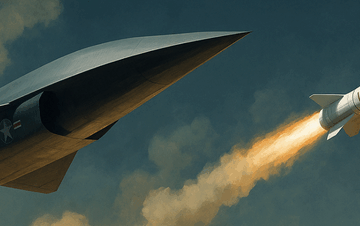The Shahed-136 loitering munition gained global attention due to its use in Russia’s war on Ukraine. This drone is relatively inexpensive, possesses a swarm capability, and has a precision-strike capability at extended ranges. The Shahed-136 is proving an effective weapon for the Russians.
A new version, the Shahed-136B, is available for use in conflict. With an extended range of 4,000 kilometers, the increasing capability of Iran’s long-range drone raises important strategic questions as this weapon’s potential uses beyond Ukraine are considered. Consider Iran’s potential response to an American attack on its nuclear facilities, should the United States and Iran fail to reach an agreement that ends Iran’s nuclear weapons program.
Shahed-136 in the Russia-Ukraine War
Iran is supplying the Shahed-136 to Russia as supply of the drone is available. Russia often uses the drone to target Ukraine’s energy infrastructure and military positions. The design of this Shahed-136 allows it to bypass traditional air defense systems due to its low radar cross-section and ability to deploy in swarms—ensuring the drone will always get through, at least some portion.
Military officials in Ukraine and the West identified the Shahed-136 as a persistent and cost-effective threat capable of overwhelming advanced air defense systems. In the case of the Shahad-136, quantity has a quality all its own. Russia’s use of this drone is giving Iran valuable battlefield data that allows designers to refine and improve the capabilities of the Shahed-136B, which is proving an even more lethal weapon.
Strategic Implications in a US-Iran Conflict
If tensions between the US and Iran escalate—particularly if the US conducts strikes against Iran’s nuclear sites—the Shahed-136B could become a key component of Iran’s retaliation strategy. With a 4,000-kilometer range, the Shahad-136B has the potential to strike American strategic assets across the region. With a large American presence spread across the Middle East, there are a large number of Americans and military targets that would make inviting targets. Although the Shahed-136B does not have the legs to strike targets beyond Southern Europe and the Middle East, the number of American bases and assets within the drone’s striking radius are significant.
Iran may also try to launch attacks from unfriendly nations in the Western hemisphere like Cuba or Venezuela or even work with Mexican drug cartels. This proximity, should such an approach work, could allow for attacks on critical targets in the United States. Iran believes the United States is seeking regime change, which will lead the regime to see any fight as a fight for survival.
While military analysts can debate the effectiveness and impact of such a response, the psychological effect achieved is significant. Israelis, for example, live in constant fear of attack from the air. An American attack on Iranian nuclear facilities or other assets would surely elicit an Iranian attack from Iran’s most advanced capabilities.
Iran has a sophisticated network of asymmetric capabilities that extend across the Middle East and Europe. This means any direct confrontation with Tehran could lead to severe and unpredictable consequences for American security. Ensuring Iran does not field a nuclear weapon may be worth the risk of an Iranian response, but it is certainly unknown just how Iran may respond and how effectively the United States and its allies can limit the effect of any response.
Rather than pushing the region toward war, President Donald Trump, who presents himself as a pragmatic negotiator, should consider engaging Iran in constructive dialogue. Despite the difficulties in recent efforts by President Trump to work with the Iranian regime, a return to diplomacy could prevent a devastating conflict that neither side can afford.
Keep in mind, the regime in Tehran feels the United States is attempting to end the regime. The desire for nuclear weapons was spurred by American forces in Iraq, Iran’s western neighbor, and Afghanistan, Iran’s northern neighbor. Ratcheting down tensions will require an American effort to create a sense of security within the Iranian leadership.
While the Shahed-136B is not the only tool in Iran’s toolkit, it is an example of the growing capability fielded by Iran. It is also a strategic consideration for the United States. Iran is unlikely to let any attack go unanswered.
Mohammad Hassan Sangtarash is an independent defense analyst in Tehran.




